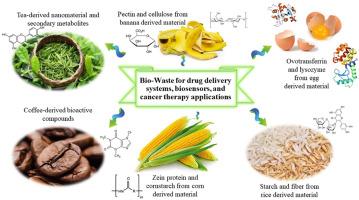Harnessing bio-waste for biomedical applications: A new horizon in sustainable healthcare
European Journal of Medicinal Chemistry Reports
Pub Date : 2024-10-18
DOI:10.1016/j.ejmcr.2024.100234
引用次数: 0
Abstract
Recent studies have focused on exploring the potential biomedical applications of compounds derived from bio-waste, responding to growing environmental concerns and the need for sustainable practices in healthcare. This review examines a wide range of bio-waste materials, including coffee extracts, banana peels, rice husks, chickpea peels, and pineapple peels, with the intention of determining their potential for use in the production of biomedical devices. The distinctive properties of these bio-waste materials are highlighted, including their antioxidative and antimicrobial characteristics, as well as their capacity to generate environmentally friendly nanoparticles. The sustainable synthesis of nanoparticles such as zinc oxide and silver facilitates the development of eco-friendly alternatives, which could be applied in various biomedical fields, including drug delivery systems, biosensors, and cancer therapy. Utilizing bio-waste not only provides an innovative avenue for advanced medical technologies but also aligns with the principles of sustainable healthcare by reducing waste and minimizing the environmental footprint of biomedical production. However, challenges remain in achieving standardization, reproducibility of outcomes, and securing necessary regulatory approvals. Future interdisciplinary collaborations should prioritize sustainability and nanotechnology to fully exploit the potential of bio-sourced materials in the biomedical sector.

利用生物废物进行生物医学应用:可持续医疗保健的新视野
最近的研究重点是探索从生物废弃物中提取的化合物在生物医学方面的潜在应用,以应对日益增长的环境问题和医疗保健领域对可持续发展的需求。本综述研究了多种生物废料,包括咖啡提取物、香蕉皮、稻壳、鹰嘴豆皮和菠萝皮,旨在确定它们在生物医学设备生产中的应用潜力。重点介绍了这些生物废料的独特性质,包括其抗氧化和抗菌特性,以及生成环境友好型纳米粒子的能力。氧化锌和银等纳米粒子的可持续合成促进了生态友好型替代品的开发,这些替代品可应用于各种生物医学领域,包括药物输送系统、生物传感器和癌症治疗。利用生物废弃物不仅为先进医疗技术提供了创新途径,而且通过减少生物医学生产过程中的废物和环境足迹,符合可持续医疗的原则。然而,在实现标准化、结果的可重复性以及获得必要的监管批准方面仍存在挑战。未来的跨学科合作应优先考虑可持续性和纳米技术,以充分挖掘生物医学领域生物源材料的潜力。
本文章由计算机程序翻译,如有差异,请以英文原文为准。
求助全文
约1分钟内获得全文
求助全文

 求助内容:
求助内容: 应助结果提醒方式:
应助结果提醒方式:


